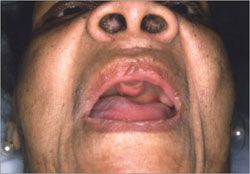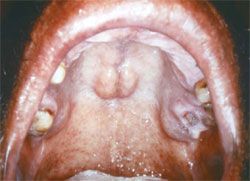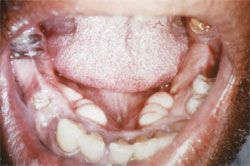- Clinical Technology
- Adult Immunization
- Hepatology
- Pediatric Immunization
- Screening
- Psychiatry
- Allergy
- Women's Health
- Cardiology
- Pediatrics
- Dermatology
- Endocrinology
- Pain Management
- Gastroenterology
- Infectious Disease
- Obesity Medicine
- Rheumatology
- Nephrology
- Neurology
- Pulmonology
A Woman With a Big Bump in the Mouth
A 67-year-old Hispanic woman is seen for routine physical examination. Has mild hypertension but no other known medical problems. Feels well. No weight loss. No reported difficulty with eating, speaking, or swallowing. Denies any discomfiture in the mouth. States that nothing has changed in her mouth “ever since I lost my baby teeth.” Does not smoke cigarettes nor drink alcohol.
This article was originally presented as an independent educational activity under the direction of CME LLC. The ability to receive CME credits has expired. The article is now presented here for your reference. CME LLC is no longer responsible for the presentation of the article.
HISTORY

A 67-year-old Hispanic woman is seen for routine physical examination. Has mild hypertension but no other known medical problems. Feels well. No weight loss. No reported difficulty with eating, speaking, or swallowing. Denies any discomfiture in the mouth. States that nothing has changed in her mouth “ever since I lost my baby teeth.” Does not smoke cigarettes nor drink alcohol.
PHYSICAL EXAMINATION
Woman who appears stated age. Vital signs and general examination, normal. Facial skin shows some telangiectases and lips have some wrinkling, suggesting solar damage. Nares unremarkable. Dorsum of tongue, normal. Anterior palate as shown.
WHAT'S YOUR DIAGNOSIS?
ANSWER: TORUS PALATINUS
A smooth mass juts down from the hard palate centrally or just barely to the left of the midline. It appears to be covered by smooth mucosa without ulcer or exudate. Two minute grooves or lobulations are seen on its left-hand surface.
On palpation the mass was bony hard beneath apparently normal mucosa. The combination is diagnostic of torus palatinus, a common variant of bony overgrowth at the palatine suture that is nonpathological.1,2 If the word torus feels half-familiar, it is from geometry, in which it refers to a doughnut shape. Somehow in anatomy this became transmogrified to a bump or protuberance.
ANY CHANCE IT IS CANCER?
The presence of a bump where we don’t expect one always raises the question of neoplasia. However, the regular surface of this lesion looks entirely innocuous, with neither the erythroplasia of early squamous cancer in the mouth,3-7 nor the ragged white look and dried exudates of a more advanced squamous carcinoma. I claim no high ground about this condition: the first one that I saw in my medical-intern year at Loyola (Chicago), in 1978, with 2 years of pathology residency already under my belt, had me worried enough that I obtained a Papanicolaou smear kit and dutifully sent off a specimen of surface cells for cytological examination. The report, of course, came back normal squamous epithelium.
Squamous cell carcinoma can very rarely develop from the mucosa overlying a torus,8 but it will be recognizable clinically there, as anywhere else in the mouth, not because of the mass of the torus, but because of change in the clinical appearance of the epithelium. A primary bone neoplasm of the jaw at this site would not be inconceivable; however, for the clinician to suspect one, discernible growth would be required, either by the patient’s history, or by serial observation. From that point, imaging might be considered, though for the ordinary torus, not even a plain radiograph is indicated.
HOW MANY PATIENTS HAVE THESE?

Tori palatini occur in a large minority of the population. The reported prevalence varies wildly, from less than 1% of Chileans, to more than half of some northern ethnic groups. No standardized nomenclature has been accepted. Tiny bumps that may be merely prominent fissures are considered small tori in some studies, nontori in others. In case this were not confusing enough, studies of skulls by anthropologists disclose a higher percentage of tori than are recognized clinically, presumably because overlying mucosa hides smaller ones. Many papers claim higher frequency in women, while others find it in men. There are claims that tori palatini are seldom identified in early childhood, but underdiagnosis is likely. Many patients even with large lesions, exceeding 30 mm in size, remain unaware into mid-life and beyond unless their dentist informs and reassures.

Many classifications based on shape, size, grooves running anteroposteriorly in the center (Figure 1), and multilobularity have been published1,2,9- 11 but don’t change the central issue which is recognition and deliberate diagnostic restraint.
The same principle applies to a corresponding lesion on the lower jaw, usually paired bilaterally interior to the dentition, called torus mandibularis (Figure 2).
ULCERATION, IRRITATION, DENTURE FABRICATION
A minority of tori cause trouble. The mucosa overlying them tends to be thin and because it overlies bone and not a more vascular substrate, such as the gingiva, appears less red and is less capable of repair. Furthermore, by “lying in the roadway” of the food bolus, such mucosa is subject to trauma regularly. So ulcers can occur, but most of them heal readily.
Only the rarest and largest or most ill-placed of tori interfere with speech, swallowing, or mastication. These require the intervention of an oral and maxillofacial surgeon as do any that present intractable problems of ulceration or discomfort.
Dentists show extraordinary creativity in the mechanics of the mouth, and in denture fabrication, which bears comparison to the craftsmanly ingenuity of orthopaedic surgeons. (I know that internists and orthopods regularly tease each other, but the above expresses nothing but genuine admiration.) They create appliances that account for and work around most tori. Occasionally even their best efforts cannot create a stable and comfortable denture for such a patient. In that case the edentulous patient with a torus11 may need surgical resection to allow an effective and tolerable prosthodontic.
A POSSIBLE NEW TWIST: BISPHOSPHONATE-INDUCED OSTEONECROSIS
Bisphosphonates have been associated with osteonecrosis of the jaw, one instance of which filled a column here last year.12 A single case report details a case putatively of the same, in a torus palatinus13 of a woman receiving multiple therapies for breast cancer with liver, lung, and bone metastases. It would make good sense that tori should carry special risk of osteonecrosis, in that the bone’s blood supply is not ideal, the mucosa is thin, and trauma, as above, is common. However, bisphosphonate- associated osteonecrosis of a torus had never been reported before; the histopathological illustration and details of the case meet both clinical and pathological criteria to my eye for osteomyelitis due to microbial (perhaps Actinomyces) invasion of an ulcer. The dead bone tissue in the image is a routine element in osteomyelitis with or without “avascular” necrosis or bisphosphonate-induced osteonecrosis. Episodic exposure to corticosteroids constitutes a distinct possible cause for osteonecrosis from this patient’s history. There was no metastatic cancer in the surgical specimen.
The area in question was cured by resection of the dead bone, which would also work for localized infection as well as for avascular necrosis.
The prospect of utilizing the examination of a torus in the search for osteonecrosis is especially attractive: Maintaining good nutrition is of paramount concern in support of patients with metastatic cancer in bone, or who have myeloma. It is precisely those patients who receive frequent, high doses of zoledronic acid: they are thus the group with the maximal incidence of bisphosphonate- induced osteonecrosis of the jaw. Because the torus is non-functional, operative treatment of it would not disrupt nutrition; and if it served as the bellwether, one might hope to avoid osteonecrosis of tooth-bearing jaw, where both disease and treatment would be less well tolerated. However, this prospect requires further study before even tentative conclusions can be drawn.
AN OSTEOPOROSIS CONNECTION
Meantime an astute observation was being followed up: an endocrinologist noticed that many postmenopausal women with large tori palatini had excellent bone density on dual-energy x-ray absorptiometry (DEXA) tests.14 Hypotheses included that tori might shrink just like bone everyplace else in the body when osteoporosis supervenes, and the preservation of larger ones would argue against osteoporosis. A very careful study utilized rigorous methods and statistical analysis of the predominant subgroup tested, postmenopausal women. The authors showed that large tori are statistically associated with favorable bone density, but not in every case, so it could not be used as an isolated decision point.14 Nevertheless, in trying to decide with an individual postmenopausal patient, particularly if risk factors are few, a large torus might help delay first densitometric testing. This constitutes a newer readily accessible physical sign on inspection, to seek insight about the internal osteoporotic process: no longer do we have only a 2-inch documented loss in height, and kyphosis, either of which occurs in advanced osteoporosis, 15 but a marker of a more favorable status; and not needing to be pathognomonic of anything to be useful.
GENERALIZABLE INSIGHT IN GENETICS
Tori have been intensely studied relative to genetic predisposition versus environmental risk factors. Some careful studies suggest that autosomal dominance applies. 16 There may also be environmental factors that cause or inhibit torus formation and growth. An intriguing observation, though only applicable to a tiny fraction of the populace, is that a gene for extra-strong bones has been identified in some families, and tori are exceptionally common in those families.
HOW MUCH HAS CHANGED IN 18 YEARS!
I addressed tori in a “What’s Your Diagnosis?” column in 1990,17 but did not use a single word of that column in preparing the present one: only three of the references cited below existed at that time. All the “systemic” connections are new. Access to the medical literature has been augmented incredibly via the e-mail to and from medical libraries, the Web, and electronic journals. From my desk, often in just 5 minutes, I can read reports and studies both new and very old: the 1959 report of cancer atop a torus, of which I was unaware in 1990, was accessed via the Yale Medical Library. I owe them a newer debt of thanks along with ongoing thanks to the wonderful librarians of Saint Francis Hospital and Medical Center, Hartford, who obtain the impossible as well as the routine reference so quickly and with such apparent ease every time I ask, that I cannot help but become more scholarly and informed, to the benefit of patients and to the improvement of these columns.
References:
REFERENCES:
1
. Jainkittivong A, Apinhasmit W, Swasdison S. Prevalence and clinical characteristics of oral tori in 1,520 Chulalongkorn University Dental School patients.
Surg Radiol Anat
. 2007;29:125-131.
2
. Seah YH. Torus palatinus and torus mandibularis: a review of the literature.
Aust Dent J.
1995;40:318-321.
3
. Lumerman H, Freedman P, Kerpel S. The oral soft tissue examination in the detection of oral cancer and other soft tissue lesions.
N Y J Dent.
1982;52:261-263.
4
. Mashberg A, Feldman LJ. Clinical criteria for identifying early oral and oropharyngeal carcinoma: erythroplasia revisited.
Am J Surg.
1988;156:273-275.
5
. Mashberg A, Samit A. Early detection, diagnosis, and management of oral and oropharyngeal cancer.
CA Cancer J Clin.
1989;39:67-88.
6
. Jainkittivong A, Aneksuk V, Langlais RP. Oral mucosal conditions in elderly dental patients.
Oral Dis.
2002;8:218-223.
7
. Scully C, Porter S. ABC of oral health. Swellings and red, white, and pigmented lesions.
BMJ.
2000;321:225-228.
8
. Miglani DC. Squamous-cell carcinoma arising in mucosa overlying torus palatinus; report of a case.
Oral Surg Oral Med Oral Pathol.
1959;12:289-293.
9
. MacInnis EL, Hardie J, Baig M, al-Sanea RA. Gigantiform torus palatinus: review of the literature and report of a case.
Int Dent J.
1998;48:40-43.
10
. Tran KT, Shannon M. Images in clinical medicine. Torus palatinus.
N Engl J Med.
2007;356:1759.
11
. Al Quran FA, Al-Dwairi ZN. Torus palatinus and torus mandibularis in edentulous patients.
J Contemp Dent Pract.
2006;7:112-119.
12
. Schneiderman H, Goldblatt R. Osteonecrosis of the jaw from high-dose bisphosphonate therapy.
Consultant.
2007;47:413-423.
13
. Goldman ML, Denduluri N, Berman AW, et al. A novel case of bisphosphonate- related osteonecrosis of the torus palatinus in a patient with metastatic breast cancer.
Oncology
. 2006;71:306-308.
14
. Belsky JL, Hamer JS, Hubert JE, et al. Torus palatinus: a new anatomical correlation with bone density in postmenopausal women.
J Clin Endocrinol Metab.
2003;88:2081-2086.
15
. Schneiderman H, Bellantonio S. Kyphosis due to osteoporotic compression fractures of thoracic vertebrae.
Consultant.
1996;36:507-509.
16
. Gorsky M, Bukai A, Shohat M. Genetic influence on the prevalence of torus palatinus.
Am J Med Genet.
1998;75:138-140.
17
. Schneiderman H. Torus palatinus, related lesions, and their differential diagnosis.
Consultant.
1990;30(11):47-48.
